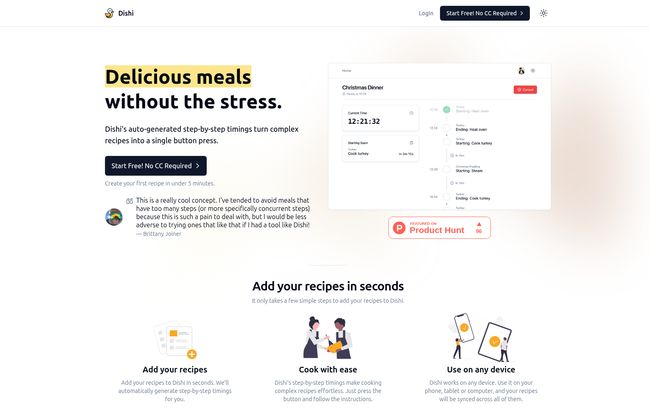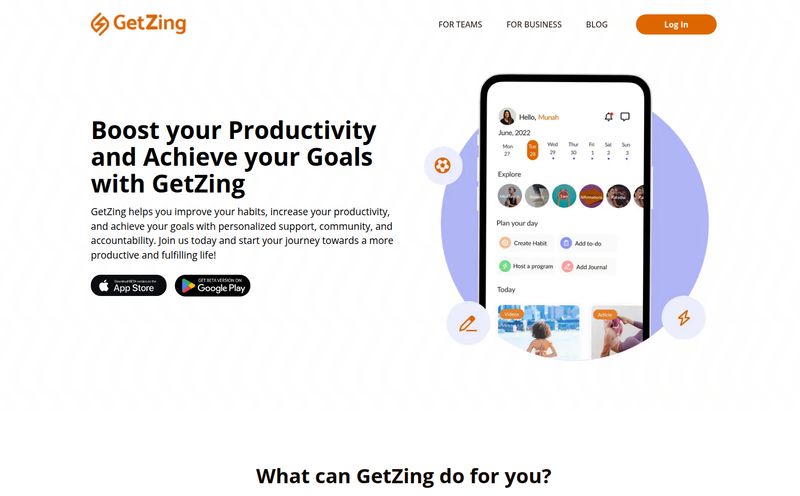We’ve all been there. It’s the big family dinner. Maybe it’s Christmas, maybe it’s just a Sunday roast you decided to attempt on a whim. The chicken needs another 20 minutes, the potatoes should have come out 10 minutes ago, the carrots are turning to mush, and you completely forgot to even start the gravy. It's a culinary ballet where every dancer is stepping on each other's toes. The mental gymnastics required to get everything on the table, hot and at the same time, can turn a labor of love into a full-blown stress-fest.
For years, my method has been a chaotic mix of phone alarms, scribbled notes on a stained napkin, and a whole lot of panicked yelling. So when I stumbled upon a new tool called Dishi, my interest was piqued. It claims to be a meal prep timer that turns complex recipes into simple, step-by-step timings with a single button press. A big promise. But as someone who lives and breathes digital tools and traffic generation, I know that the simplest ideas are often the most powerful. So, I decided to take it for a spin and see if it could really deliver on its promise of “delicious meals without the stress.”
What Exactly is Dishi? More Than Just a Kitchen Timer
Let's get one thing straight: Dishi isn't just another timer app on your phone. You have plenty of those. Think of it more like an orchestra conductor for your kitchen. You give it the sheet music (your recipe), and it tells each instrument (each dish component) exactly when to start playing so it all comes together in a harmonious finale.
The website puts it brilliantly: “If you can use a microwave, you can use Dishi.” I love that. It cuts through the tech jargon and gets straight to the point. The core idea is that you add the different parts of your meal and their cooking times, and the app calculates the entire timeline for you, from the first prep step to the final plating. It’s designed to eliminate that constant, nagging question: “Okay, what do I need to be doing right now?”
My First Impressions: Getting Started with Dishi
Signing up was a breeze. The homepage screams “Start Free! No CC Required,” which is music to the ears of anyone tired of signing up for a trial only to forget and get billed a month later. The interface is clean, minimalist, and refreshingly straightforward. No clutter, no confusing menus. It’s clear this tool was built to do one job and do it well.
The Big “But”: You Have to Bring Your Own Recipes
After signing up, I hit the first major realization. Dishi doesn't come pre-loaded with recipes. This isn't a discovery platform like Allrecipes or a fancy meal kit service. You have to manually input the recipes and their steps yourself. For a second, I was a bit let down. Another data-entry task? Ugh.
But then I thought about it more. This isn't really a bug; it's a feature. It means I can use my recipes. I can use my grandma’s handwritten, slightly illegible recipe for lasagna that’s been passed down for generations. I can use that weirdly specific chicken dish I tore out of a magazine in 2008. It works for the food you actually want to cook, not just what’s in a database. It puts the power back in your hands, which, in my opinion, is a huge plus. It’s about orchestrating your meal, not just following someone else’s plan.

Visit Dishi
Putting Dishi to the Test: A Sunday Roast Challenge
To really see if Dishi had the chops, I threw the classic kitchen gauntlet at it: a full Sunday roast. We’re talking a whole chicken, crispy roast potatoes, honey-glazed carrots, and a proper gravy made from the pan drippings. This is exactly the kind of meal where timing is everything.
I started by adding the components:
- Roast Chicken: Prep 15 mins, Cook 90 mins
- Roast Potatoes: Prep 10 mins, Parboil 10 mins, Roast 50 mins
- Glazed Carrots: Prep 5 mins, Cook 25 mins
- Gravy: Prep 5 mins, Cook 10 mins (needs to happen after chicken is out)
I entered these steps into Dishi. The process was intuitive. Then came the moment of truth. I hit the button. Instantly, a timeline appeared. It told me the total cooking time and laid out a clear schedule: “Start prepping chicken at 4:15 PM,” “Put potatoes in to boil at 5:20 PM,” “Take chicken out to rest at 6:00 PM,” “Start gravy at 6:05 PM.”
It was… beautiful. All the mental load, all that frantic calculation, was just… gone. I wasn’t thinking three steps ahead; I was just following a simple, clear set of instructions. And guess what? Everything finished within minutes of each other. The chicken was juicy, the potatoes were perfect, and for once, I wasn't a sweaty, stressed-out mess when we sat down to eat.
Who is Dishi Actually For?
After my successful test, I started thinking about who would get the most out of this tool. It’s surprisingly broad.
I think it’s perfect for the overwhelmed novice cook who wants to try more ambitious meals but is terrified by the logistics. It’s also a fantastic tool for the experienced home chef who loves a good project but hates the mental drudgery of planning. For busy parents trying to juggle a multi-part family meal after a long day, this could be an absolute lifesaver. It’s like a digital sous-chef that keeps you on track. And because it's so simple, even my most tech-resistant relatives could probably use it without a single phone call for help.
The Good, The Bad, and The Timely
So, let's break it down. No tool is perfect, right? The genius of Dishi is its profound simplicity. It focuses on one of the most stressful parts of cooking and solves it elegantly. The ability to have your recipes sync across your computer and phone is also a modern must-have. I loved being able to plan the meal on my laptop and then have the timeline right there on my phone in the kitchen.
On the flip side, the manual recipe input can feel a bit tedious, especially for a dish with ten or more steps. I found myself wishing for some kind of URL importer, though I understand that might compromise the simplicity. It’s also important to remember what Dishi isn't. It won’t give you nutritional information, it won't generate a shopping list, and it won’t teach you how to chop an onion. It’s a timing specialist, and it stays firmly in its lane. For some, that might be a drawback; for me, I appreciate the focus.
What About Dishi's Pricing?
This is the million-dollar question, or in this case, the zero-dollar question. As of writing this, Dishi is free to use, with no credit card required to sign up. The website doesn't have a public pricing page, which suggests it might be in an early-access phase or planning to introduce a freemium model down the line. Perhaps a “Dishi Pro” with advanced features could be in the works? Honestly, for the value it provides in reducing kitchen stress, I wouldn’t be surprised if a paid tier appeared later. For now, though, it’s completely free, which makes it a no-brainer to try.
Comparing Dishi to Other Kitchen Tools
How does Dishi stack up? Well, it’s not really competing with most recipe apps. Apps like Paprika are fantastic for storing and organizing recipes, but their timer functions are generally basic. Dishi isn’t trying to be a recipe box.
It’s competing with our old habits. It’s a direct upgrade from the “pen and paper” method. It’s a consolidation of the “multiple phone alarms” method, saving you from a cacophony of beeps and buzzes. It’s a specialized tool for a specialized problem, and in that niche, it doesn't have a lot of direct competition. It carves out its own unique space in the digital kitchen.
Frequently Asked Questions about Dishi
How much does Dishi cost?
Currently, Dishi is free to use. You can sign up and start creating meal timelines without providing any payment information. There is no public information about future pricing plans at this time.
How does Dishi sync across devices?
When you create an account, your recipes and timelines are saved to that account. You can then log in on any device—your phone, tablet, or computer—and all your information will be there waiting for you.
What about my privacy and my recipes?
While I'm not a lawyer, you own your recipe content. Like most web apps, Dishi will have a privacy policy that outlines how they handle your data, which is typically stored securely on their servers to enable the syncing feature.
Can Dishi import recipes from a URL?
As of now, it appears recipes need to be entered manually. This ensures accuracy for the timing generator but does mean there’s no feature to automatically pull a recipe from a blog or cooking website.
Is Dishi good for weekly meal prep?
Absolutely. If you're batch-cooking several dishes for the week, you can enter them all into Dishi to create an efficient timeline for your entire prep session, ensuring everything gets cooked in the right order.
Does it work for baking too?
Yes! Baking is all about precise timing, from proofing dough to cooling cakes. Dishi is an excellent tool for managing multi-step baking projects where different components need to be ready at specific times.
So, Should You Get Dishi? My Final Verdict
Look, new apps and platforms pop up every single day. Most are just noise. But every once in a while, something simple, elegant, and genuinely useful comes along. Dishi feels like one of those tools.
It’s not going to revolutionize your entire life. It’s not an all-in-one kitchen command center. But it does one thing—managing the complex timing of cooking—exceptionally well. It takes a significant source of stress and just… erases it. It gives you back the brainpower to actually enjoy the process of cooking, to taste as you go, to perfect the seasoning, rather than just worrying about the clock.
If you're someone who loves to cook but gets tangled up in the logistics, you owe it to yourself to give Dishi a try. It might just be the secret ingredient you’ve been missing. For the glorious price of free, it could be the best deal you find for your kitchen all year.
Reference and Sources
- Dishi's appearance on Product Hunt: Dishi on Product Hunt
- General recipe management apps discussed: Paprika Recipe Manager



